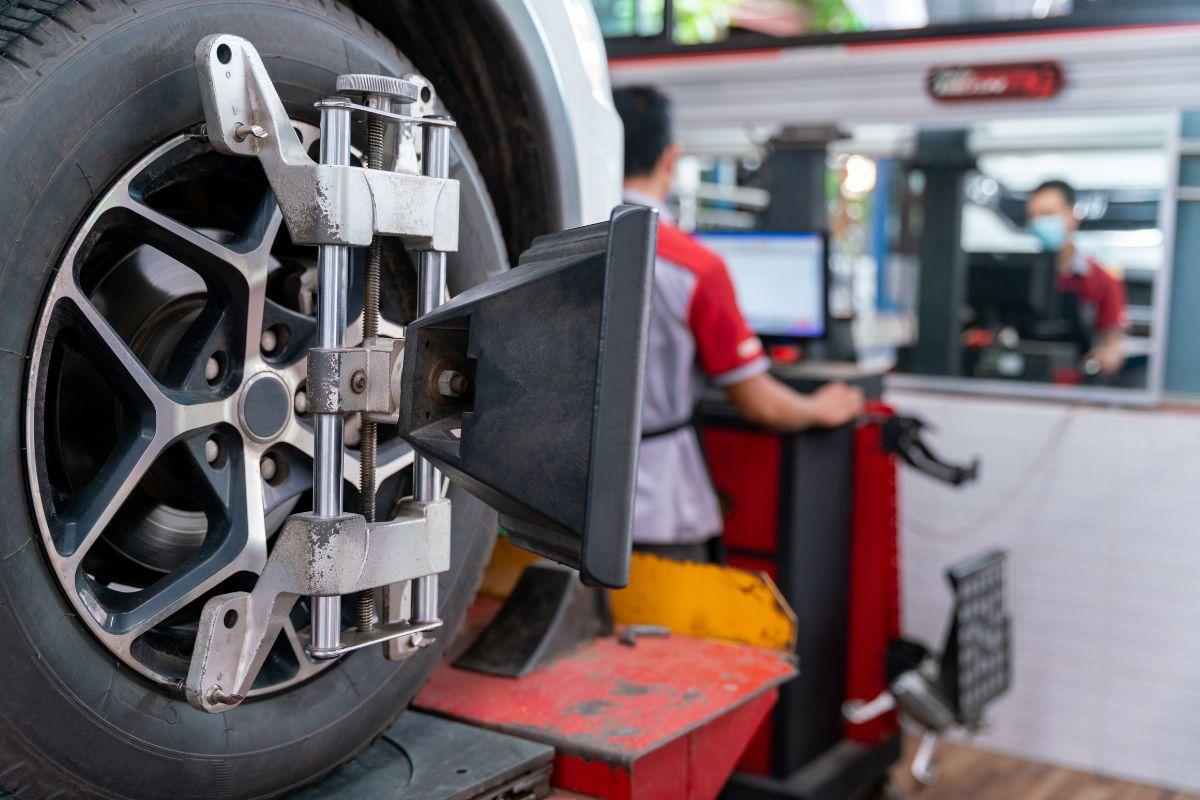Wheel Balancing 101: How to Eliminate Vibration and Extend Tire Life

A small vibration at highway speeds can feel harmless — until it wears out tires, strains suspension parts, and turns a comfortable commute into a nagging problem. Wheel balancing is one of the simplest, most cost-effective wheel repair solutions that keeps a vehicle stable, safe, and comfortable. This guide explains what wheel balancing is, why it matters, the different balancing methods technicians use, how to tell when your wheels are out of balance, and what to expect from a trusted provider like Premier Color and Wheels. By the end you’ll understand how professional balancing protects performance, extends tire life, and preserves ride comfort.
What is wheel balancing?
Wheel balancing is the process of equalizing the weight distribution around the entire wheel-and-tire assembly so it spins smoothly at speed. Even brand-new tires and factory wheels can have small weight variances. When these variances line up in a way that creates uneven mass around the rotating assembly, the result is vibration. Balancing corrects that by placing small weights at the appropriate points on the rim or by using more advanced techniques that consider tire stiffness and contact patch irregularities.
Why balancing matters: performance, comfort, and cost
Unbalanced wheels create more than just vibration. The consequences include:
-
Uneven tire wear — which shortens tire life and increases replacement cost.
-
Steering wheel, seat, or floorboard vibration — which reduces comfort and can mask other issues.
-
Extra strain on wheel bearings, suspension bushings, and shocks — accelerating component failure.
-
Reduced fuel efficiency in extreme cases, because the drivetrain works harder to compensate for inefficiency.
A professional balance is a small, affordable investment that prevents costlier repairs and delivers a safer, more user-friendly driving experience.
Signs your wheels need balancing
You don’t have to be a mechanic to notice the most common symptoms. Typical signs include:
-
A vibration in the steering wheel between 45–70 mph.
-
A vibration felt through the seat or floor at higher speeds (often rear-wheel related).
-
Tires showing feathered or cupped wear patterns after relatively short mileage.
-
New tires or wheels installed and an immediate vibration appears.
If you observe any of these, a quick visit to a reputable wheel repair shop for a diagnostic spin on a balancing machine is a proven first step.
Static vs. dynamic balancing — what the terms mean
There are two basic balancing approaches:
Static balancing corrects for a single heavy spot on the wheel that causes the assembly to wobble up and down. It’s usually done by placing a weight on the rim’s inner or outer edge. Static balancing is simple and effective for some imbalances, but it doesn’t address paired or lateral issues.
Dynamic balancing corrects both vertical and side-to-side imbalances. Modern dynamic balancers spin the wheel and calculate where weights must be placed on both the inside and outside of the rim to neutralize forces. Dynamic balancing is the trusted, industry-leading approach used in most professional shops because it handles more complex weight variations.
Road-force balancing: when ordinary balancing isn’t enough
Road-force balancing (also called force variation balancing) uses a heavy roller to simulate road contact and identify lumps or stiffness in the tire that a standard balancer can miss. The machine applies a load while spinning the wheel to measure how the tire behaves under pressure. If a tire has a stiff spot, patch, or internal defect, road-force balancing helps the technician recommend a fix — often rotation and match-mounting or, in severe cases, tire replacement. For drivers who demand high-performance steering or that have persistent vibration after dynamic balancing, road-force balancing is a cutting-edge solution that produces superior results.
How balancing is performed — step by step
-
Technician removes the wheel and mounts it on the balancing machine.
-
The machine spins the assembly and measures imbalance forces.
-
The technician adds weights (clip-on or adhesive) where the machine indicates.
-
If necessary, the technician repeats the spin until the readings are within acceptable tolerances.
-
For road-force balancing, the assembly is pressed against a roller to measure force variation; the technician may rotate or remount the tire to minimize the variation.
-
Final wheel torque, balance check, and in many shops, a quick test drive confirm the repair.
Professional shops follow calibrated procedures and keep equipment maintained so the result is reliable and long-lasting.
How much does balancing cost and how often should it be done?
Balancing is generally an affordable service — often performed when new tires are installed or part of a routine maintenance package. Prices vary by region and the balancing method used (standard dynamic balancing is less costly than road-force balancing). Balancing is recommended whenever tires are mounted, after a tire repair that involved removing the tire, or anytime you notice symptoms. As a rule of thumb, check balance every 5,000–7,500 miles or as advised by your tire manufacturer and technician.
Common myths and mistakes
Myth: Balancing is only for high-performance cars. Reality: Any car with uneven weight distribution benefits from balancing.
Myth: Heavy adhesive weights are inferior. Reality: Adhesive weights can be ideal for alloy wheels where clip-on weights might damage the rim finish; modern adhesives are proven and reliable.
Mistake: Replacing tires without checking balance or alignment. Reality: New tires should always be balanced and the vehicle aligned when necessary to ensure longevity and a smooth ride.
Wheel balancing as part of broader wheel repair solutions
Balancing can’t correct bent rims, severe tire damage, or worn suspension parts. A trusted shop that offers wheel repair solutions will inspect rims for bends or corrosion, check tire condition, and verify suspension components before completing balancing. When combined with proper wheel straightening, refinishing, and alignment services, balancing becomes part of a results-driven maintenance plan that keeps your vehicle safe, efficient, and comfortable.
Case study: How Premier Color and Wheels solved a persistent vibration
A local customer brought a mid-size SUV to Premier Color and Wheels complaining of a steering vibration at highway speeds after a recent tire purchase. The technician performed a standard dynamic balance; the machine showed small weights were needed on all four wheels. After balancing, the vibration reduced but did not disappear at 65 mph. The team then recommended a road-force balance. That test revealed a significant force variation in the front-right tire due to a manufacturing stiffness. The technician match-mounted the tire — rotating it so the stiff spot aligned with a lower point on the wheel — and applied precise adhesive weights. Premier Color and Wheels also checked wheel straightness and performed a quick alignment.
Outcome: The vibration was eliminated, tire wear returned to normal patterns over the next few hundred miles, and the customer avoided an unnecessary tire replacement. This case highlights how a top-rated, experienced shop uses layered diagnostics — dynamic and road-force balancing plus fitment checks — to deliver a reliable, user-friendly solution.
Choosing a reliable wheel balancing provider
When you pick a shop, consider these factors:
-
Equipment quality: Modern dynamic and road-force balancers yield the most accurate results.
-
Technician experience: Well-experienced technicians interpret readings and recommend the right fix.
-
Transparent diagnostics: The shop should explain what the machines show and why a particular method is chosen.
-
Fitment and finish care: If you have alloy wheels, ask about adhesive-weight options to protect the rim finish.
-
Proven track record: Look for a trusted provider that offers a warranty or satisfaction guarantee.
Premier Color and Wheels combines industry-leading equipment with affordable, proven service practices to provide balanced results and long-term reliability for your wheels.
Final checklist before you leave the shop
-
Confirm weights are secured and not rubbing against brake components.
-
Request a test drive if you still feel vibrations.
-
Keep service records — they help diagnose future issues quickly.
-
Inspect tires monthly for uneven wear patterns that can indicate balance or alignment problems.
Final thoughts
Wheel balancing is a simple, affordable wheel repair solution with outsized benefits: smoother rides, longer tire life, and fewer suspension headaches. Whether you’re addressing a vibration, fitting new tires, or tuning for performance, choose a shop that uses proven techniques and transparent diagnostics. Premier Color and Wheels offers trusted balancing services — from routine dynamic balancing to advanced road-force balancing — ensuring your ride remains comfortable, safe, and dependable.
- Art
- Causes
- Best Offers
- Crafts
- Dance
- Drinks
- Film
- Fitness
- Food
- Jogos
- Festival
- Gardening
- Health
- Início
- Literature
- Music
- Networking
- Outro
- Party
- Religion
- Shopping
- Sports
- Theater
- Wellness



